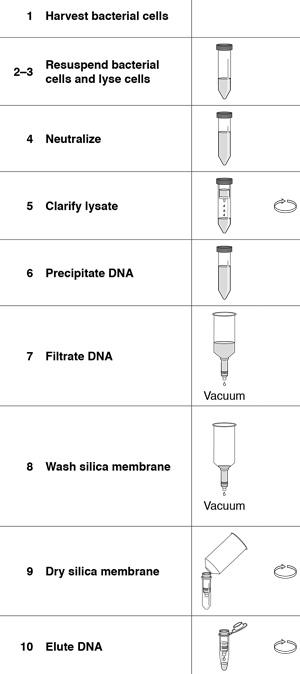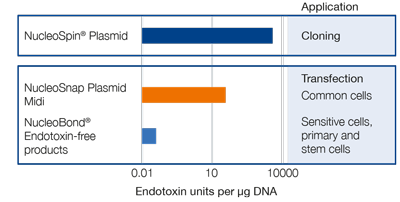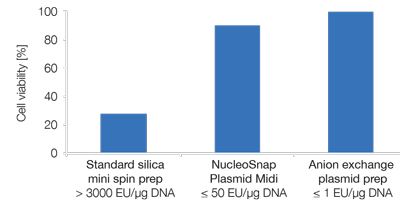The NEW generation of plasmid midi preparation
- New column design (snap-off column) for vacuum processing of large sample volumes
- Transfection-grade plasmid DNA for sensitive downstream applications
- Isolate up to 700 μg plasmid DNA in only 35 minutes
Request Free Sample
| Technology |
Silica-membrane technology |
| Processing |
Vacuum processing (e.g., using NucleoVac 24 Vacuum Manifold), centrifugation for elution
|
| Format |
Snap-off column |
| Endotoxin level |
< 50 EU/µg DNA (EU = Endotoxin Units) |
| Sample material |
Up to 50 mL E. coli culture (OD600=5) |
| Lysate clarification |
NucleoSpin® Plasmid Filter Columns (2 min centrifugation) |
| Vector size |
≤ 25 kbp |
| Typical yield |
400–700 µg (50 mL culture, OD600=4, high-copy plasmid) |
| A260/A280 |
1.8–1.9 |
| Elution volume |
200–500 µL |
| Preparation time |
35 min/6 preps |
| Binding capacity |
1.5 mg |
Applications
Principle/Procedure
The NucleoSnap® Plasmid Midi kits are designed for the rapid purification of highly pure plasmid DNA from up to 50 mL of a standard E. coli overnight culture. Plasmid DNA isolated with this kit is suitable for all common downstream applications like enzymatic digestion, cloning, sequencing, PCR amplification, transformation, and transfection (research use only).
E. coli cells are grown in a standard culture medium under appropriate selective conditions and harvested by centrifugation.
Cells are resuspended in Resuspension Buffer SN1 and afterwards lysed by Lysis Buffer SN2 containing sodium dodecyl sulfate and sodium hydroxide. Alkaline conditions ensure a complete and almost immediate denaturation of DNA and proteins. Addition of Neutralization Buffer SN3 precipitates potassium dodecyl sulfate complexes with bacterial cell debris, proteins, and macromolecular contaminants and neutralizes the pH value resulting in a re-annealing of the covalently closed circular plasmid DNA which remains soluble.
Debris is removed by a filtration step with the specially designed NucleoSpin® Plasmid Filter Columns. The clear flow-through contains plasmid DNA while genomic DNA, cell remnants, and most of the protein are filtered out and can be discarded.
The flow-through containing the plasmid DNA is mixed with Precipitation Buffer SN4 and loaded into a NucleoSnap® Plasmid Midi Column, connected to a vacuum device. Vacuum is applied until the solution has passed the filtration matrix completely. Endotoxins are washed away by Endotoxin Removal Buffer SN5, salts, and further impurities are subsequently removed by a washing step with ethanolic Wash Buffer SN6.
Residual ethanol from Wash Buffer SN6 is efficiently removed by centrifugation in a microcentrifuge. To enable the use of a microcentrifuge, the NucleoSnap® Columns are equipped with a predetermined breaking point and can be divided into a funnel component and a Mini spin column by a simple break action.
Plasmid DNA is eluted in Elution Buffer SNE (5 mM Tris / HCl, pH 8.5) and is ready for any common downstream application. No further clean-up steps are required.
NucleoSnap® Plasmid Midi procedure

NucleoSnap® (Snap-off columns) principle

Application data
Endotoxin levels appropriate for individual applications
A quantitative chromogenic LAL-test was used to assess endotoxin content. As indicated, the content of endotoxin is strongly depended on the technology of plasmid purification. Low endotoxin levels were detected after purification with NucleoSnap® Plasmid Midi, resulting in a plasmid solution directly appropriate for transfection of common cells.

High cell viabilites of eukaryotic cells
Eukaryotic Huh-7 cells were transfected with Lipofectamin 2000 and 2.5 μg plasmid DNA (pCMV-GFP, kindly provided by Plasmid-Factory GmbH & Co. KG, Bielefeld, Germany). The plasmid DNA was prepared with a standard silica mini spin prep (such as NucleoSpin® Plasmid), NucleoSnap® Plasmid Midi and an anion exchange DNA isolation kit (such as NucleoBond® Xtra Midi EF).

Request Free Sample
For more detailed information and documents, click here.
The supporting documents available for this product can be downloaded below.



